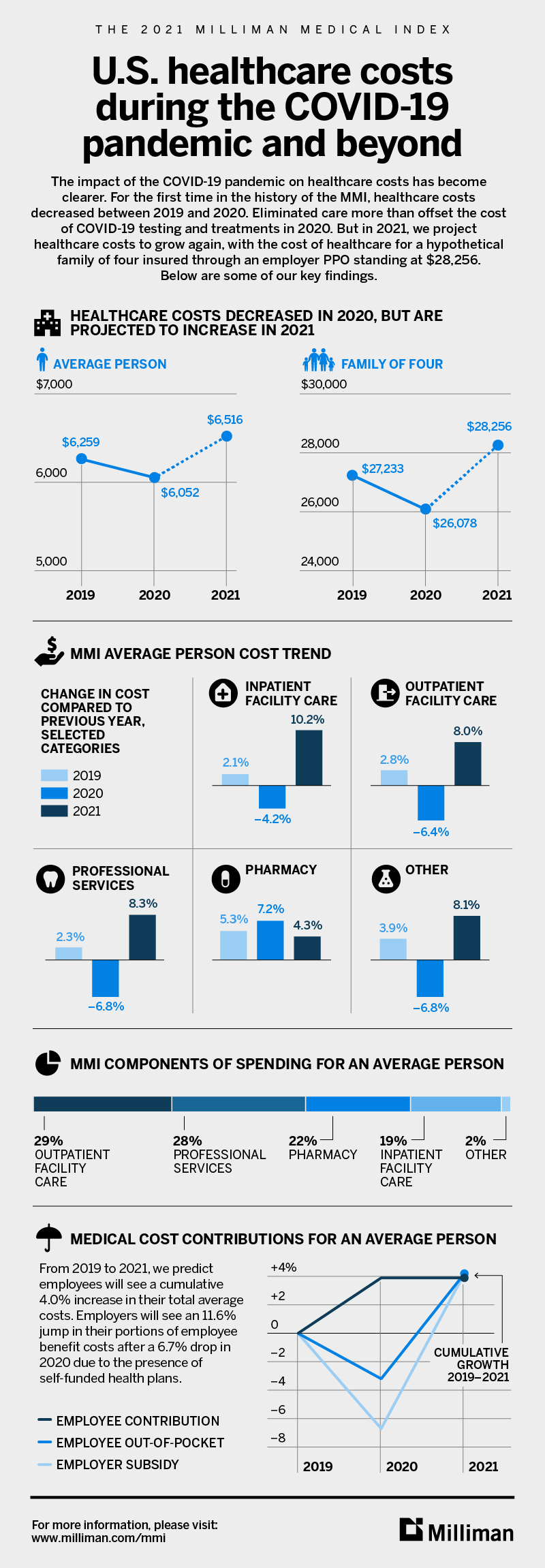Key findings of the 2021 MMI include:
2020: Looking back
- For the first time in the history of the MMI, healthcare costs decreased year over year with our restated 2020 MMI being 4.2% lower than the 2019 MMI value. Eliminated and deferred care has more than offset the cost of COVID-19 testing and treatments. All categories of healthcare costs except prescription drugs with and without rebates are lower in 2020 compared to 2019.
- We published last year’s MMI on May 21, 2020, near the beginning of the COVID-19 pandemic. At that time, we suspected that the pandemic would have an effect on healthcare costs but we did not have enough data to understand the duration and extent of the impact. We now know much more about how COVID-19 has affected 2020 but there is still much unknown for 2021 and beyond.
- Our 2020 MMI report suggested that COVID-19 testing and treatment costs “may be dwarfed by the spending reductions resulting from deferrals of care.” This hypothesis turned out to be true although it appears that much of the care has actually been eliminated rather than deferred. It is unclear to what extent this eliminated care will lead to future adverse health outcomes, if any.
- The year 2020 was unique in many regards. Lifestyle changes may have contributed to less demand for acute care in the short term. Digital health, telehealth, and mail-order pharmacy utilization increased as individuals accessed care in new ways. It is uncertain whether these new behaviors will persist, revert to pre-COVID-19 behaviors, or change in some new way when the public health emergency is over.
- Last year, we examined the effects of managed care on healthcare costs. Care management will be a key in controlling healthcare costs in 2021 and beyond, perhaps by leveraging the new care access habits formed by many individuals during the height of the pandemic.
2021: Looking ahead
- We project healthcare costs will grow by approximately 8.4% for the MMI family from 2020 to 2021. This rate, driven by a forecasted rebound in healthcare utilization, is higher than historical healthcare cost increases and gross domestic product (GDP) growth over the past five years.
- As we look ahead to 2021, we are faced with more uncertainty than ever before. COVID- 19 vaccine penetration rates and efficacy, public health policy and individual responses to new developments, and new utilization patterns and behaviors all add to this uncertainty. However, we have never been better equipped to navigate this new level of uncertainty. Our resources, including our COVID-19 modeling suite, Milliman’s Health Trend Guidelines, and Milliman’s MedInsight® Emerging Experience data, give us an early look at how healthcare costs are shaping around COVID-19.
It’s important to note that changes in healthcare costs are different for the average person, the MMI family, and other groups of people. Our interactive tool gives readers the ability to see health costs for the MMI family and different family compositions. Use the tool below to build your own family and understand their healthcare costs.
For MMI results at a glance, see our infographic below:
